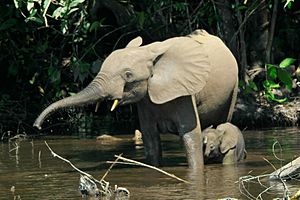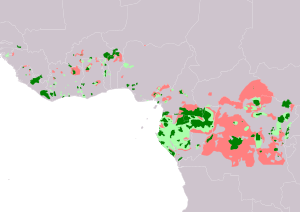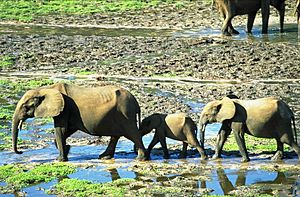African forest elephant facts for kids
Quick facts for kids African forest elephantTemporal range: Pleistocene - Recent
|
|
|---|---|
 |
|
| African forest elephants in Nouabalé-Ndoki National Park | |
| Conservation status | |
| Scientific classification | |
| Genus: |
Loxodonta
|
| Species: |
cyclotis
|
 |
|
| Range of the African forest elephant Resident Possibly Extant (resident) Possibly extinct | |
The African forest elephant (Loxodonta cyclotis) is one of the two living African elephant species. It is native to humid forests in West Africa and the Congo Basin. It is the smallest of the three living elephant species, reaching a shoulder height of 2.4 m (7 ft 10 in). Both sexes have straight, down-pointing tusks, which erupt when they are 1–3 years old. It lives in family groups of up to 20 individuals. Since it forages on leaves, seeds, fruit, and tree bark, it has been referred to as the 'megagardener of the forest'. It contributes significantly to maintain the composition and structure of the Guinean Forests of West Africa and the Congolese rainforests.
The first scientific description of the species was published in 1900. During the 20th century, overhunting caused a sharp decline in population, and by 2013 it was estimated that less than 30,000 individuals remained. It is threatened by habitat loss, fragmentation, and poaching. The conservation status of populations varies across range countries. Since 2021, the species has been listed as Critically Endangered on the IUCN Red List.
African forest elephants are estimated to constitute up to one-third of the continent's elephant population but have been poorly studied because of the difficulty in observing them through the dense vegetation that makes up their habitat.
Contents
Taxonomy
Loxodonte was proposed as the generic name for African elephants by Frédéric Cuvier in 1825. This name refers to the lozenge-shaped enamel of the molar teeth, which differs significantly from the shape of the Asian elephant's molar enamel. Loxodonte was latinized to Loxodonta by an anonymous author in 1827.
Elephas (Loxodonta) cyclotis was the scientific name proposed by Paul Matschie in 1900 who described the skulls of a female and a male specimen collected by the Sanaga River in southern Cameroon.
The African forest elephant was long considered to be a subspecies of the African elephant, together with the African bush elephant. Morphological and DNA analysis showed that they are two distinct species.
Description
Bulls of the species reach a shoulder height of 2.4–3.0 m (7 ft 10 in – 9 ft 10 in). Females are smaller at about 1.8–2.4 m (5 ft 11 in – 7 ft 10 in) tall at the shoulder. Males weigh 4,000–7,000 kg (8,800–15,400 lb), while females only 2,000–4,000 kg (4,400–8,800 lb). Foot print size ranges from 12.5 to 35.3 cm (4.9 to 13.9 in).
The African forest elephant has grey skin, which looks yellow to reddish after wallowing. It is sparsely covered with black coarse hair, which is 20–200 mm (0.8–8 in) long around the tip of the tail. The length of the tail varies between individuals from half the height of the rump to almost touching ground. It has five toenails on the fore foot and four on the hind foot. Its back is nearly straight. Its oval-shaped ears have small elliptical-shaped tips and the tip of the trunk has two finger-like processes.
The African forest elephant's tusks are straight and point downwards, and are present in both males and females. The African forest elephant has pink tusks, which are thinner and harder than the tusks of the African bush elephant. The length and diameter vary between individuals. Tusks of bulls grow throughout life, tusks of cows cease growing when they are sexually mature. The tusks are used to push through the dense undergrowth of their habitat. Their tusks can grow to about 1.5 m (4 ft 11 in) long and can weigh between 23 and 45 kg (50 and 100 lb).
Distribution and habitat
Populations of the African forest elephant in Central Africa range in large contiguous rainforest tracts from Cameroon to the Democratic Republic of the Congo, with the largest stable population in Gabon, where suitable habitat covers 90% of the country.
However, it is estimated that the population of African forest elephants in central Africa declined by around 86% in the 31 years preceding 2021 owing to poaching and loss of habitat. In addition, Cameroon, Congo and the Central African Republic have suffered from high levels of conflict. The first survey in 30 years in 2021, by the Wildlife Conservation Society and the National Parks of Gabon, reported an estimated 95,000 forest elephants in Gabon. Prior to this the population had been estimated at 50,000 to 60,000 individuals.
They are also distributed in the evergreen moist deciduous Upper Guinean forests in Ivory Coast and Ghana, in West Africa.
Behaviour and ecology
The African forest elephant lives in family groups. Groups observed in the rain forest of Gabon's Lopé National Park between 1984 and 1991 comprised between three and eight individuals. Groups of up to 20 individuals were observed in the Dzanga-Sangha Complex of Protected Areas, comprising adult cows, their daughters and subadult sons. Family members look after calves together, called allomothering. Once young bulls reach sexual maturity, they separate from the family group and form loose bachelor groups for a few days, but usually stay alone. Adult bulls associate with family groups only during the mating season. Family groups travel about 7.8 km (4.8 mi) per day and move in a home range of up to 2,000 km2 (770 sq mi).
They use a complex network of permanent trails that pass through stands of fruit trees and connect forest clearings with mineral licks. These trails are reused by humans and other animals.
In Odzala-Kokoua National Park, groups were observed to frequently meet at forest clearings indicating a fission–fusion society. They stayed longer when other groups were also present. Smaller groups joined large groups, and bulls joined family units.
Diet
The African forest elephant is an herbivore. Elephants observed in Lopé National Park fed mostly tree bark and leaves, and at least 72 different fruits. To supplement their diet with minerals, they congregate at mineral-rich waterholes and mineral licks.
Elephant dung piles collected in Kahuzi-Biéga National Park contained seeds and fruit remains of Omphalocarpum mortehanii, junglesop (Anonidium mannii), Antrocaryon nannanii, Klainedoxa gabonensis, Treculia africana, Tetrapleura tetraptera, Uapaca guineensis, Autranella congolensis, Gambeya africana and G. lacourtiana, Mammea africana, Cissus dinklagei, and Grewia midlbrandii. Dung piles collected in a lowland rain forest in the northern Republic of Congo contained seeds of at least 96 plant species, with a minimum of 30 intact seeds and up to 1102 large seeds of more than 1 cm (0.39 in) in a single pile. Based on the analysis of 855 dung piles, it has been estimated that African forest elephants disperse a daily mean of 346 large seeds per 1 km2 (0.39 sq mi) of at least 73 tree species; they transport about a third of the large seeds for more than 5 km (3.1 mi).
Seeds passed by elephant gut germinate faster. The African forest elephant is one of the most effective seed dispersers in the tropics and has been referred to as the "megagardener of the forest" due to its significant role in maintaining plant diversity. In the Cuvette Centrale, 14 of 18 megafaunal tree species depend on seed dissemination by African forest elephants, including wild mango (Irvingia gabonensis), Parinari excelsa and Tridesmostemon omphalocarpoides. These 14 species are not able to survive without elephants. African forest elephants provide ecological services that maintain the composition and structure of Central African forests.
Communication
Little is known about how African forest elephants communicate. For these mammals, hearing and smell are the most important senses they possess because they do not have good eyesight. They can recognize and hear vibrations through the ground and can detect food sources with their sense of smell. Elephants have the ability to see just as well in dim light as they can in the daylight. They are capable of doing so because the retina in their eyes adjusts nearly as quickly as light does.
The elephant's feet are sensitive and can detect vibrations through the ground, whether thunder or elephant calls, from up to 10 miles away.
Reproduction
Females reach sexual maturity between the age of 8 and 12 years. On average, they begin breeding at the age of 23 and give birth every 5–6 years.
Baby elephants weigh around 105 kg (232 lb) at birth. Almost immediately, they can stand up and move around. The baby suckles using its mouth while its trunk is held over its head. Their tusks do not come until around 16 months and calves are not weaned until they are roughly 4 or 5 years old.
Forest elephants have a lifespan of about 60 to 70 years. Between the ages of 15 and 25, bulls experience "musth", which is a hormonal state they experience marked by increased aggression. The male secretes fluid from the temporal gland between his ear and eye during this time. When in musth, bulls have a more erect walk with their head high and tusks inward, they may rub their heads on trees or bushes to spread the musth scent, and they may even flap their ears, accompanied by a musth rumble, so that their smell can be blown toward other elephants. Bulls only return to the herd to breed or to socialize; they do not provide prenatal care to their offspring but rather play a fatherly role to younger bulls to show dominance.
Females are capable of conceiving multiple times a year, which is a reason why they do not appear to have a breeding season.
Threats
People cut down forests for livestock farming, planting crops, and building urban and industrial areas. As a result, both African elephant species are threatened by habitat loss and habitat fragmentation. Poaching for ivory and bushmeat is a significant threat in Central Africa. Because of a spike in poaching, the African forest elephant was declared Critically Endangered by the IUCN in 2021 after it was found that the population had decreased by more than 80% over 3 generations.
Habitat fragmentation leaves some elephants confined to small patches of forest without sufficient food. In January 2014, International Fund for Animal Welfare undertook a relocation project at the request of the Ivory Coast government, moving four elephants from Daloa to Assagny National Park.
Conservation
In 1986, the African Elephant Database was initiated with the aim to monitor the status of African elephant populations.
Both African elephant species have been listed by the Convention on International Trade in Endangered Species of Wild Fauna and Flora on CITES Appendix I since 1989. This listing banned commercial international trade of wild African elephants and their parts and derivatives by countries that signed the CITES agreement. Populations of Botswana, Namibia and Zimbabwe were listed in CITES Appendix II in 1997 as was the population of South Africa in 2000. Hunting elephants is banned in the Central African Republic, Democratic Republic of Congo, Gabon, Côte d'Ivoire, and Senegal.
See also
 In Spanish: Elefante africano de bosque para niños
In Spanish: Elefante africano de bosque para niños









